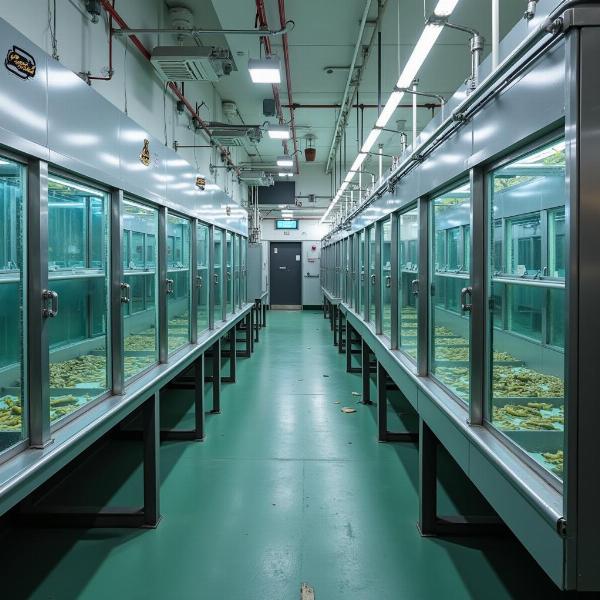Fish breeding, a crucial aspect of aquaculture, refers to the process of raising fish in a controlled environment for commercial or recreational purposes. Understanding the meaning and intricacies of fish breeding is essential for anyone involved in the fisheries sector in India. This guide explores the various aspects of “fish breeding meaning in hindi,” providing a comprehensive overview of its terminology, techniques, and significance.
Understanding “Fish Breeding Meaning in Hindi”
The Hindi term for fish breeding is “मछली पालन” (machhli palan), which encompasses the entire process of raising and cultivating fish. While “machhli palan” can be broadly translated as fish farming or pisciculture, it inherently includes the concept of breeding. Other related terms include “प्रजनन” (prajanan), meaning reproduction, and “संजनन” (sanjanan), referring to breeding or procreation. These terms, while not exclusively used for fish, are frequently applied in the context of fish breeding. Knowing these terms can greatly enhance your understanding of discussions surrounding fish breeding in Hindi.
Techniques in Fish Breeding
Fish breeding techniques vary based on the species and desired outcome. Induced breeding, a common practice, involves injecting hormones to stimulate reproduction. This method allows for controlled spawning and increases the yield. Another method is selective breeding, where fish with desirable traits are chosen for reproduction to enhance the quality of future generations. This can focus on factors like size, disease resistance, or growth rate. Understanding these techniques and their Hindi equivalents is vital for effective communication within the Indian aquaculture industry.
Importance of Fish Breeding in India
Fish breeding holds immense significance in India, contributing substantially to food security, employment, and economic growth. With a vast coastline and numerous inland water bodies, India possesses immense potential for aquaculture. Fish breeding provides a sustainable source of protein and essential nutrients, particularly crucial in a country with a large population.
Different Types of Fish Farming in India
India employs diverse fish farming methods, each suited to specific environments and species. These methods include:
- Pond culture: Traditional and widely practiced, involving raising fish in earthen or concrete ponds.
- Cage culture: Involves enclosing fish within floating cages in open water bodies.
- Tank culture: Utilizes tanks of varying sizes for controlled fish breeding, often employed for ornamental fish.
- Integrated fish farming: Combines fish farming with other agricultural practices, like poultry or livestock rearing, creating a synergistic system.
The Role of Hatcheries in Fish Breeding
Hatcheries play a crucial role in fish breeding by providing a controlled environment for spawning and rearing fish larvae. They ensure a consistent supply of fish seed, reducing dependence on wild catches and promoting sustainable aquaculture practices. Understanding hatchery meaning in hindi is important for understanding the entire fish breeding process.
 Modern Fish Hatchery in India
Modern Fish Hatchery in India
Challenges and Future of Fish Breeding in India
Despite its potential, fish breeding in India faces challenges like disease outbreaks, water pollution, and climate change. Addressing these issues through research, innovation, and sustainable practices is critical for the future of the industry. Exploring new species and breeding techniques, like cultivating fish that thrive in brackish water or developing disease-resistant strains, can significantly boost the sector. Learning about different aquatic environments like riverine meaning in hindi or meaning of lagoons in hindi can open up new possibilities for fish breeding. Understanding the characteristics of various species such as egret meaning in hindi (though not a fish, but an indicator of healthy aquatic ecosystems) or reticulate meaning in hindi (a descriptive term for some fish patterns) can broaden knowledge of aquatic life and its interconnection.
Conclusion
Fish breeding meaning in Hindi encompasses a range of terms and practices essential for successful aquaculture. From traditional pond culture to modern hatchery technology, understanding these aspects is crucial for anyone involved in the Indian fisheries sector. By addressing the challenges and embracing sustainable practices, India can unlock the full potential of fish breeding, contributing to food security, economic growth, and the livelihoods of millions.
FAQ
- What is the most common method of fish breeding in India? Pond culture remains the most prevalent method due to its relative simplicity and affordability.
- What is the meaning of induced breeding? Induced breeding involves injecting hormones to stimulate fish reproduction.
- Why are hatcheries important for fish breeding? Hatcheries provide a controlled environment for spawning and larval rearing, ensuring a consistent supply of fish seed.
- What are some challenges faced by the fish breeding industry in India? Disease outbreaks, water pollution, and climate change pose significant challenges.
- How can fish breeding contribute to India’s economy? Fish breeding generates employment, provides a valuable food source, and contributes to export revenue.
About Meaning-Hindi.in
Meaning-Hindi.in is your trusted partner for high-quality Hindi translation services. We specialize in various domains, including business, legal, technical, website localization, educational, and specialized translations. Our expertise ensures accurate and culturally sensitive translations, catering to diverse needs. For all your Hindi translation requirements, contact us at [email protected] or +91 11-4502-7584. Meaning-Hindi.in is committed to bridging language barriers and facilitating effective communication.